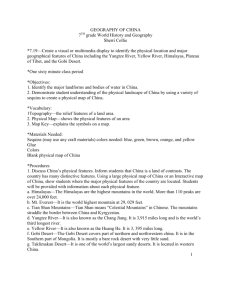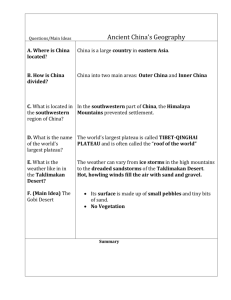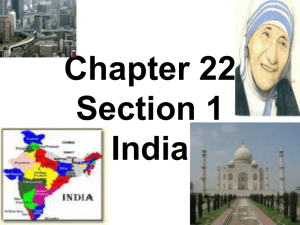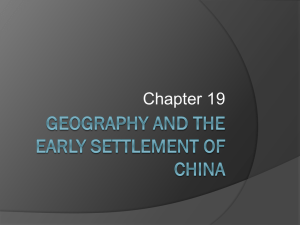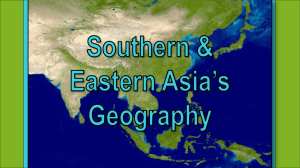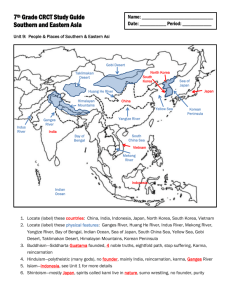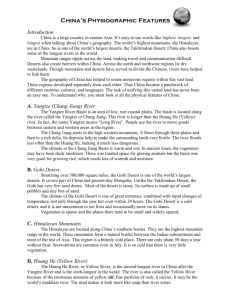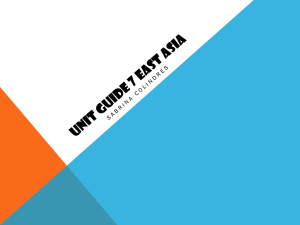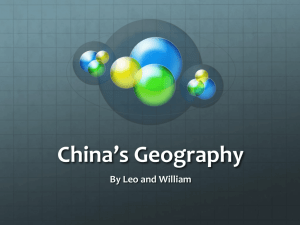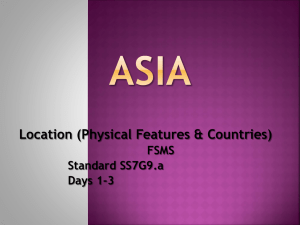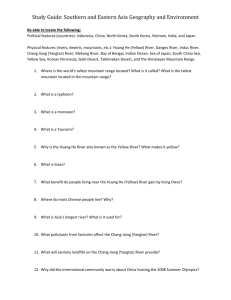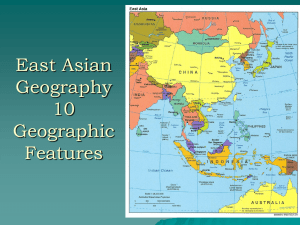SS7Ga,b - lfmsdevaney
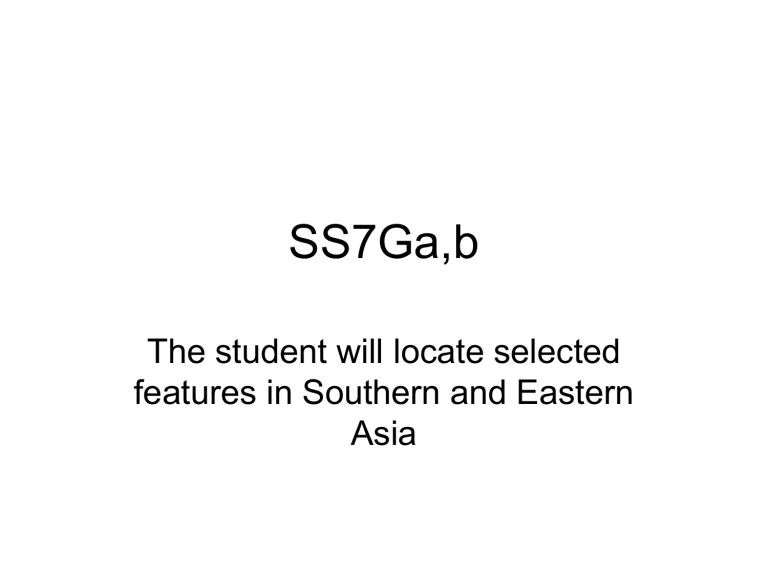
SS7Ga,b
The student will locate selected features in Southern and Eastern
Asia
a. Locate on a world and regional political-physical map:
Ganges River, Huang He (Yellow River), Indus River,
Mekong Delta, Yangtze (Chang Jiang) River, Bay of
Bengal, Indian Ocean, Sea of Japan, South China Sea,
Yellow Sea, Gobi Desert, Taklimakan Desert, Himalayan
Mountains, and the Korean Peninsula
The southern and eastern parts of Asia are home to almost half of the world’s population.
The geography of this large area is varied, containing some of the world’s longest rivers, highest mountain ranges, and most extensive deserts.
Indus River
• Begins in the mountains of Tibet and flows almost 2000 miles through the country of
Pakistan before emptying into the Arabian
Sea.
• Indus River valley is one of the richest farming areas in this region.
• Many different civilizations have lived along this river throughout the centuries.
Ganges River
• India’s most important river.
• Begins in the Himalayan Mountains and flows southeast through India and Bangladesh before emptying into the Bay of Bengal.
• Carries tons of sediment (topsoil, silt and minerals from the mountains) and gradually spreads it along the way enriching farmland and creating a large, fertile delta at the mouth of the river.
• Many people live and work along the Ganges causing the water to be heavily polluted.
Ganges River
• Bangladesh is located almost completely in the Ganges River delta.
• Heavy flooding occurs during the monsoon season when the prevailing wind, lasting several months, brings heavy rains to this area.
• Causes great hardships for the people of
Bangladesh.
• West of India is the Indian Ocean (3 rd largest)
Himalayan Mountains
• Form the southern border of China
• High ground spreads to the north to form the Tibetan Plateau.
• Sometimes referred to as the “roof of the world” because of the high altitudes.
• The mountains and plateaus block moisture coming from the rivers and seas to the south.
Himalayan Mountains
• Form India’s eastern border with China and Nepal.
• Create a barrier between India and countries to the north and east.
• Stretch nearly 200 miles.
• Highest mountain in the world, Mount
Everest, is on the border between Nepal and China.
Taklimakan Desert
• Mountains begin to level off to the north
• Land becomes desert.
• Taklimakan and Gobi Deserts can be found there.
• Taklimakan is over 600 miles long (one of the longest in the world.
Gobi Desert
• To the west and in the central part of
China.
• Can be one of the hottest and also coldest places in the world.
• Much is covered with sand and rocks.
Huang He (Yellow River)
• Begins in mountainous plateau of Tibet.
• Flows toward east and empties into the
Yellow Sea.
• Yellow dust from Gobi Desert is picked up by the Huang He and carried along as loess (silt).
• Gives the river and the sea a yellowish color.
Huang He (Yellow River)
• Also deposited along the river’s path, creating rich soil for farmers.
• River important for transporting people and goods.
• Annual floods can make conditions dangerous.
• Frequent flooding has led the Huang He to sometimes be called “China’s Sorrow.”
Yangtze River (Chang Jiang)
• Also begins in the Tibetan Plateau.
• Travels east until it reaches the East China
Sea.
• Shanghai, one of China’s most important ports is located at the mouth of this river.
• Yangtze is over 3400 miles long making it
China’s longest river.
• Goes through fertile farming land and is a major transportation route.
Yangtze River (Chang Jiang)
• Yangtze and Huang He River are connected by the Grand Canal, one of he world’s oldest and longest canal systems.
• Oldest parts were built over 2000 years ago.
Mekong River
• Begins in Tibetan Plateau.
• Runs south from China through Myanmar,
Thailand, Laos, Cambodia, and finally
Vietnam.
• Empties into South China Sea.
• Mekong River delta has some of the richest farming land in the world.
Korean Peninsula
• Mountainous peninsula (land surrounded by water on three sides)
• Attached to China
• Bordered by Yellow Sea and the Sea of
Japan.
• Over half is mountains.
• Still plenty of rich farmland.
• Divided into two countries since the end of
World War II. (North and South Korea)
* More about this later.
Sea of Japan
• Small sea bound by Russia to the north, the Korean Peninsula to the west and
Japan to the east.
Physical Features of SE Asia
b. Locate on a world and regional political-physical map the countries of China, India, Indonesia, Japan, North
Korea, South Korea, and Vietnam
